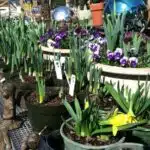Do you want to bring a burst of color and beauty to your garden? Dutch Irises are the perfect choice! These stunning flowers will instantly transform your landscape and give any garden an incredible boost. With their beautiful ruffled petals and vibrant colors, Dutch Irises are sure to delight anyone who appreciates truly exceptional flora. But be warned: cultivating these incredible specimens is no easy task! Fortunately, with the right knowledge and approach, you can learn how to grow Dutch Irises that will be the envy of your friends and family.
As a specialist in botany and gardening, I am here to tell you that with a bit of effort, Dutch Irises can reward you with some of the most spectacular displays of color imaginable! Their petals come in an array of bright shades such as blue, purple, yellow and white. Some varieties even have two-tone petals for an extra special touch. They also tend to bloom for longer than other types of irises – sometimes up to 6 weeks or more – so they’re sure to make a lasting impression on all who see them in your garden.
For those serious about creating a beautiful outdoor space featuring Dutch Irises, it is important to understand how best to care for them. From selecting the ideal location within your garden to proper planting techniques, there’s much more involved than meets the eye when learning how to grow these stunning flowers successfully. Read on for all the information you need about growing Dutch Irises!
Planting Dutch Irises
Dutch irises are a popular choice in gardens, with an array of colors and fragrances that can transform a flower bed. With the right care, they can provide beautiful blooms season after season. According to the Royal Horticultural Society, dutch irises are one of the most long-lived flowers, surviving in many climates for up to twenty years.
Planting dutch irises is simple and requires just a few steps. First, choose a spot that has full sun or partial shade and well-drained soil. If your soil is clay-based or tends to hold too much moisture, consider amending it with plenty of organic material like compost. Water your bulbs immediately after planting them and then water them once a week throughout the growing season until flowering time. To maximize bloom production, fertilize your bulbs every month during spring and summer with a balanced fertilizer like 10-10-10.
Dutch irises also thrive when planted among other plants such as daylilies or peonies. Planting these together helps create texture contrast while providing extra nutrients for better growth – both of which will result in more vibrant flowers come bloom time! With proper care and attention, you can enjoy gorgeous blooms from dutch iris year after year!
Soil Requirements For Dutch Irises
When it comes to growing Dutch Irises in your garden, the type of soil is of paramount importance. When it comes to soil requirements for Dutch Irises, you’ll want to focus on nutrient-rich soil that drains well. Soil should be slightly acidic with a pH of between 6 and 7.5.
The best way to ensure this is by adding organic matter such as compost or peat moss into the soil before planting. Make sure the soil is loose and not compacted for optimal growth. Adding a layer of mulch will also help retain moisture and keep weeds away from the delicate iris roots. Finally, make sure the area receives at least 6 hours of direct sunlight each day for healthy blooms.
TIP: To boost drainage in clay soils, incorporate sand or gravel into your mix when preparing the beds for planting Dutch Irises. This will help create an ideal environment for these beautiful flowers to thrive!
Watering Dutch Irises
Dutch irises are a popular plant, with gardeners around the world enjoying their showy blooms. In fact, one survey revealed that up to 40% of gardeners in the United States grow Dutch irises in their gardens. Thus, it is important to understand the best practices for caring for these plants.
Watering is an essential part of Dutch iris care. During the summer months when the plants are actively growing, they should be watered thoroughly at least once per week or more if needed during dry spells. The soil should be kept evenly moist but not soggy or overly wet as this can lead to root rot and other problems. To test if your Dutch iris needs water, stick your finger into the soil; if it feels dry 2-3 inches below the surface, then it is time to water.
In addition, careful consideration must be given to how you water your Dutch irises as well. These plants do not tolerate overhead watering, so it’s best to use drip irrigation or hand-watering with a watering can placed close to the base of each plant. Avoid getting foliage wet as this can increase susceptibility to fungal diseases like botrytis blight and powdery mildew.
In order for Dutch irises to thrive and reach their full potential, they need proper fertilization too. It is important to provide them with balanced fertilizer regularly throughout the growing season.
Fertilizing Dutch Irises
Now that we have discussed the importance of watering Dutch irises, it is essential to focus on fertilizing them for healthy growth. This can be done through a few simple steps, but before beginning the process, it is important to remember to wear gardening gloves and protective eyewear. Additionally, one should make sure that their hands are clean before handling the plants or fertilizer.
When it comes to fertilizers, there are a few options available for Dutch irises that will help promote growth and healthy blooms:
• Natural Fertilizers: Compost tea and mulch are great ways to naturally provide nutrients for Dutch irises. Applying these materials around the base of the plant during springtime will help promote strong root development over time.
• Synthetic Fertilizers: There are many kinds of synthetic fertilizers available on the market specifically designed for flowering plants like Dutch irises. It is important to follow the application instructions provided by the manufacturer as specific amounts of nitrogen and phosphorus may be needed at certain times in order to effectively fertilize your plant.
• Organic Fertilizers: If you prefer organic solutions, there are a variety of organic fertilizers available that can help promote healthy blooms and foliage in Dutch iris plants. Many of these products contain ingredients such as fish meal or seaweed extract which can provide essential trace elements for your plants’ health.
By providing adequate amounts of nutrients with natural, synthetic, or organic fertilizers, gardeners can ensure that their Dutch irises remain healthy throughout each stage of growth. With proper care and attention, these beautiful flowers will continue to bring color and beauty into any garden setting for years to come!
Next up we’ll explore how propagation techniques can be used to increase your collection of Dutch irises quickly and easily!
Propagating Dutch Irises
The propagation of dutch irises is an interesting and rewarding process. It’s a great way to increase the collection of these beautiful flowers in your garden. There are two basic methods to propagate Dutch irises: division and seed.
Division allows you to create multiple new plants from one existing clump of bulbs. The best time to divide is after flowering, when they have finished blooming and have begun to die back. You’ll need to carefully dig up the entire clump, then separate out the individual bulbs, discarding any that are diseased or damaged. Replant them in well-drained soil, keeping the bulbs about 6 inches apart for optimal growth.
Seed propagation is also another option for growing dutch iris plants from scratch. Seeds can be collected from existing plants after flowering has ceased and allowed to dry out before sowing directly into prepared beds in early spring or autumn months of the year. Keep them moist until germination has occurred and thin them out so each plant has enough space once they reach maturity.
Propagating Dutch irises may take some patience and practice, but with careful attention, you can easily increase your collection of these lovely flowers over time! An exciting prospect awaits as you watch your hard work blossom in due season!
Deadheading Dutch Irises
Deadheading Dutch Irises is a key part of a robust gardening practice. It’s an essential component of keeping these flowers looking their best, and allowing them to flourish. To deadhead simply means to remove any withered or dying blooms from the plant. This allows for new blooms to develop and prevents the plant from expending energy on producing seed.
To successfully deadhead Dutch Irises, you’ll need to pay close attention to the growth cycle and bloom times for your particular variety. After the initial bloom has finished, it’s time to remove all of the old flowers, as well as any foliage that may be damaged or diseased. Make sure you take care when doing this – use sharp secateurs or scissors and cut just above the leaf joint – this will encourage further flowering throughout the season.
It’s also important that you clear up around your Dutch Irises regularly – remove any spent petals or debris which might have fallen onto surrounding soil. This will help keep your garden tidy and ensure that pests don’t start colonising nearby plants! Now let’s move on to controlling pests and diseases – another vital part of a successful Dutch Iris garden!
Controlling Pests And Diseases
Controlling pests and diseases is essential for growing Dutch irises. Just like any other garden flowers, Dutch irises can be vulnerable to a variety of pest and disease issues. As botanists and gardeners, we must take proactive steps to keep our plants healthy.
An apt metaphor to illustrate the importance of controlling pests and diseases in Dutch irises is that of a house. If you don’t take care of your house – by cleaning, painting, replacing broken furniture, etc. – then sooner or later it will become infested with vermin and riddled with decay. Similarly, if we do not take the necessary steps to protect our Dutch irises from pests and diseases, then eventually they too will succumb to these afflictions.
In order to control pests and diseases in Dutch irises, there are several measures we can take. We should start by ensuring that our soil is healthy, as unhealthy soil can be a breeding ground for pests and disease-causing organisms. Additionally, we should regularly inspect our plants for signs of infection or pest activity such as wilting leaves or tiny insects on the petals. If signs of infection are detected, then appropriate action should be taken quickly in order to prevent further damage to the plant.
By taking proactive steps such as these we can make sure that our Dutch irises stay healthy throughout the season so that they will produce beautiful blooms year after year. With good winter care for Dutch irises, their beauty can be enjoyed well into the colder months when many other flowers have withered away.
Winter Care For Dutch Irises
Dutch Irises are hardy perennials that require special care during the winter season. It is essential to prepare the plants for cold weather, as this will ensure their survival and flowering in the spring. To understand how to properly care for your Dutch Irises during the winter months, it is important to consider several key factors.
Firstly, Dutch Irises should be cut back at the end of summer or early autumn so that they can enter a dormant state. This will allow them to better survive cold temperatures while also eliminating diseased foliage and allowing new growth in the spring. Additionally, mulching your irises with a layer of organic matter such as straw or pine needles can help insulate them against frost damage.
Finally, it is important to water your Dutch Irises throughout the winter months when there is no snow cover on the ground. This will help ensure that their root system stays healthy and protected from extreme temperatures. With proper care and attention, your Dutch Irises should survive any winter without issue and bloom again by late spring or early summer.
By following these steps you will have taken all necessary precautions for ensuring healthy winter care of your Dutch Irises – making sure they are ready for companion planting in late spring or early summer!
Companion Planting With Dutch Irises
Companion planting with dutch irises can be a great way to create a vibrant and beautiful garden. According to gardening experts, the most important factor when companion planting is to consider the environment that various plants need in order to thrive. As such, it’s important to understand the needs of dutch irises when considering what plants should be planted with them. While there are many options for companion plants, here are some of the best choices for growing alongside dutch irises.
One interesting statistic is that companion planting can increase yields by up to 20%. This means that not only will you have a beautiful garden full of colorful flowers, but you may also potentially increase your harvests of fruits and vegetables if you choose the right companion plants.
When selecting companion plants for dutch irises, be sure to select species that prefer similar growing conditions as those that dutch irises require. Good choices include hemerocallis (daylilies), coreopsis (tickseed), phlox (carpet phlox), veronica (speedwell) and salvia farinacea (mealycup sage). Additionally, other bulbs such as tulips or crocus can also work well with dutch irises in a garden setting. Planting these companions around the base of dutch iris plants will ensure they have enough light and space to grow and bloom fully.
By taking into consideration the specific requirements of both dutch iris and their companion plants, you can create an attractive and productive garden space full of colorful blooms throughout the season. With careful selection and thoughtful placement, companion planting with dutch irises can add beauty and bounty to your home’s landscape.
Tips For Cut Flower Arrangements
Cut flower arrangements are a beautiful way to bring the beauty of Dutch Irises into your home or garden. When done right, these vibrant blooms become a unique artistic expression that can transform any space. To help you get started, here are three tips for creating stunning cut flower arrangements with Dutch Irises:
First, always harvest your irises on a dry day. If you wait until after rainfall, the flowers will be weighed down and won’t stand up straight in the arrangement. Second, remove any foliage that would fall below the water line in your vase to avoid bacterial growth and keep your flowers looking fresh. Third, cut each stem at an angle so it can easily absorb water and have plenty of room to grow in the vase.
Another key tip for creating eye-catching arrangements is to create a foundation of greenery and other filler flowers before adding Dutch Irises as the focal pieces. Try combining yarrow or euphorbia with green foliage like eucalyptus or ferns for an interesting contrast to the bright colors of the irises. Additionally, avoid overcrowding by using odd numbers of stems; this helps ensure that each bloom stands out while still creating balance in the design.
Arranging cut flowers is both an art and a science – but with these simple steps you’ll be able to easily create stunning displays with Dutch Irises that will brighten up any corner of your home or garden! Next up, let’s discuss how to design a garden filled with these gorgeous blooms.
Designing A Dutch Iris Garden
Designing a Dutch Iris garden can be an inspiring and rewarding experience. Picture stepping out into a garden filled with the beauty of the irises’ blooms, in all their elegant hues. To create this stunning landscape, it’s important to understand some basic tips for growing Dutch Irises.
First, you’ll need to decide whether you want your Dutch Irises planted in small clusters or large masses. If you choose to go with mass planting, plan on adding three plants per square foot. When it comes to soil, Dutch Irises do best in well-draining soil that is slightly acidic and contains lots of organic matter. For optimal blooming, keep your iris bed in full sun throughout the day.
Here are four key tips for designing a Dutch Iris garden: • Select an area that gets at least six hours of direct sunlight each day • Amend your soil with organic matter prior to planting • Plant your bulbs about 8 inches deep and 10 inches apart • Fertilize regularly during the spring and summer months
These tips will help ensure your Dutch Iris garden looks lush and vibrant season after season. With some care and attention, you can have a beautiful display of blooms that will add color and charm to any outdoor space.
Creating A Mass Planting Of Dutch Irises
Creating a mass planting of Dutch irises is an absolute must for any garden! The sheer beauty and brilliance of these flowers make them the envy of all gardens. They are a true masterclass in nature’s artistry, with their vibrant colors and delicate petals. You can create a stunning display by planting them en masse!
The key to success is to select the right variety for your climate and soil type. If you’re not sure what to choose, consult with a specialist in botany or gardening who will be able to provide advice on the best plants for your location. Planting Dutch Irises in clusters ensures that they will have enough space to spread out and blossom without crowding each other out. When planting, make sure that the soil is moist but not soggy, and that the plants receive plenty of sunshine during the day.
Once they’re planted, it’s important to keep up with maintenance tasks such as deadheading, fertilizing, and weeding. Regular monitoring of water levels is also necessary as too much moisture can lead to rot. These simple steps will help ensure that your Dutch Iris garden looks its best year after year! With just a little bit of effort and care, you can enjoy its beauty for years to come.
With this foundation in place, it’s time to move on to tackling some of the challenges associated with growing Dutch Irises successfully.
Challenges Of Growing Dutch Irises
It’s no surprise that Dutch Irises are a favorite among gardeners. They’re easy to grow and thrive in most climates. But, as with any plant, there are challenges when it comes to growing them. Let’s take a look at some of the common challenges you may face when growing Dutch Irises:
• Unfavorable Conditions:
- Temperatures: Dutch Irises need temperatures between 45 and 65 degrees Fahrenheit for optimal growth.
- Soil Type: They prefer soil that is well-drained and fertile. Poor drainage can cause root rot.
- Sunlight: Most varieties do best in full sun with some afternoon shade in hot climates.
• Pest Infestations: Dutch Irises are susceptible to several pests, including aphids, earwigs, slugs, and snails. Regularly inspecting your plants for signs of infestation will help prevent the spread of these pests.
• Disease Susceptibility: Like many other plants, Dutch Irises are vulnerable to fungal diseases such as rust and leaf spot, as well as bacterial infections such as crown rot and blackleg. Preventive measures include proper watering practices, avoiding overcrowding of plants, and providing adequate air circulation around the foliage.
To ensure success with your Dutch Iris garden, it’s important to be aware of these potential problems and take appropriate steps to mitigate them by providing suitable environmental conditions for the plants.
Preservation And Propagation Of Dutch Irises
Preservation and propagation of dutch irises – the art of cultivating these beautiful blooms. Allusion to the flowers’ grace and elegant hues, as they fill up gardens with their delicate petals, can transport one to a world of beauty. The task of upholding this beauty requires an understanding of how to handle them with care. Here’s what one needs to know:
Storing Bulbs: Dutch iris bulbs should be stored in a cool, dry place until ready for planting. Make sure that the soil or peat moss is kept moist and not overly wet as too much moisture can cause rot.
Planting Time: When it’s time for planting, dig holes about 8-10 inches deep with a spacing of 4-6 inches apart. Keep in mind that when the plants reach maturity, their foliage will spread out and require more space than initially anticipated.
Bloom Timing: Dutch irises bloom from mid spring through summer depending on the climate conditions, so plan accordingly when deciding when to plant them. Additionally, it’s important to note that they won’t bloom again if not deadheaded after flowering ends as this helps prevent seed formation which can take away energy from blooming again in future years.
These are some essential tips for taking proper care of dutch irises while ensuring that they stay healthy and happy in your garden or yard. With a little bit of patience and understanding, you’ll be able to enjoy these beautiful flowers for years to come. Now let us explore how to use them as container plantings!
Dutch Irises For Container Plantings
Growing Dutch irises is a delight beyond belief! Whether you’re a beginner or an expert gardener, this beautiful flower will bring joy to your garden like nothing else. And when it comes to container plantings, Dutch irises are simply unbeatable. Here’s why:
Firstly, their eye-catching blooms are unrivaled in terms of size and beauty. They come in a range of colors, from classic purples and blues to whites and even yellows – so you can create a look that’s totally unique to you. Secondly, they don’t require much maintenance – just some deadheading after flowering and the occasional watering session. Thirdly, they’re incredibly hardy plants that can withstand both harsh winters and hot summers without any trouble at all. Finally, they make for amazing cut flowers – so you can enjoy their presence indoors as well as out!
When it comes to container planting with Dutch irises, there are a few simple steps that need to be taken in order to ensure success. Firstly, choose a potting mix specifically formulated for bulbs; this is essential as it allows for better drainage and helps promote healthy root growth. Secondly, be sure not to pack the soil too tightly; instead settle the bulbs in gently so that there is still plenty of air space around them. Thirdly, water regularly but avoid getting water on the foliage – this can cause disease and rot in the roots if left unchecked. Lastly, when planting multiple bulbs in the same pot make sure they are spaced out evenly; this will help ensure each bulb has enough room to grow successfully.
By following these steps, gardeners can easily take advantage of Dutch iris’s outstanding beauty while enjoying its easy care requirements! With just a little bit of effort anyone can have stunning container displays full of these gorgeous blooms year after year – what could be better than that?
Frequently Asked Questions
How Long Do Dutch Irises Take To Bloom?
If you’ve never grown Dutch Irises before, you may be wondering how long it takes for them to bloom. The good news is that with the right care and maintenance, Dutch irises can produce beautiful blooms in as little as a few weeks.
However, the exact time it takes for your Dutch irises to bloom will depend on a variety of factors, such as the type of soil they’re planted in and the amount of sunlight and water they receive. Additionally, the age of the bulbs will also have an effect on when they’ll flower; newly planted bulbs may take longer than those that have been established for several years.
For best results, it’s important to provide your Dutch irises with rich soil and plenty of sunlight throughout their blooming season. Make sure to water them regularly and fertilize them if needed in order to ensure they stay healthy and produce vibrant flowers. With proper care and attention, you can enjoy stunning blossoms from your Dutch irises in no time at all!
How Deep Should Dutch Irises Be Planted?
When it comes to planting dutch irises, the depth is of utmost importance. These plants need to be planted at a depth of around 6 inches (15 cm) in the soil. For beds that are lower than the average height of 6 inches, you can reduce the depth of planting slightly. It’s important to note that if these bulbs are planted too shallow or deep, they won’t develop properly or flower as expected.
It’s essential to ensure that the soil is well drained and that it holds enough moisture for these bulbs to thrive. When planting them, make sure you add an organic matter such as aged compost or manure so they can receive maximum nutrition from this extra dose of nutrients. Once planted, water them thoroughly and cover them with mulch if needed to retain moisture and keep weeds away.
To ensure proper development and beautiful blooms from your dutch irises, it’s important to get the depth just right when planting them. By following these simple guidelines, you’ll be rewarded with a stunning display of color in no time!
How Often Should Dutch Irises Be Fertilized?
Fertilizing Dutch Irises is an important part of their growth and health. It’s essential to keep them strong, vibrant and healthy. Like a gardener’s elixir of life, fertilizer can help Dutch irises reach their true potential. It’s important to understand how often Dutch irises should be fertilized in order to get the best results from your garden flowers.
Symbolically, Dutch irises represent a reminder of beauty and life’s simple pleasures. To nourish these beauties properly requires proper care, which includes regular fertilization with the right nutrients. Here are three key tips that will help you fertilize your Dutch irises:
- Select a slow-release fertilizer specifically designed for bulbs – this will give your flowers all the nutrients they need over a longer period of time;
- Fertilize every four weeks during the growing season – this will ensure that your blooms stay as vibrant as possible;
- Avoid overwatering – too much water dilutes fertilizer and prevents it from doing its job effectively.
As a specialist in botany and gardening, I know firsthand that providing adequate nutrition for Dutch iris plants is essential for them to flourish. With proper fertilization, you can create beautiful blossoms that will not only bring joy to those around you but also help serve others through their beauty and grace.
What Type Of Soil Is Best For Dutch Irises?
When it comes to growing Dutch irises, the type of soil you use is a critical factor in their success. As a specialist in botany and gardening, I’d like to share some tips on how to choose the right soil for these flowers.
The ideal soil for Dutch irises should be well-draining and neutral in pH. A sandy loam or a mix that includes compost is best, as it provides good drainage while also providing sufficient moisture and essential nutrients. When preparing the soil, it’s important to dig down at least 8 inches deep and remove any stones or debris that may impede drainage. Additionally, if your soil is naturally acidic, adding lime can help bring it into balance.
When planting Dutch irises, make sure not to bury them too deeply – no more than 3 inches below the surface – and space them about 6 inches apart. Once planted, water well but avoid overwatering as this can cause root rot. If you follow these guidelines and provide them with regular maintenance throughout the growing season, your Dutch irises should thrive in their new home!
What Is The Best Climate For Growing Dutch Irises?
Growing Dutch irises successfully requires a particular climate. In general, they prefer temperate climates that have cool and wet winters, and hot and dry summers. They also do best in areas with plenty of sunshine during the day. These conditions are usually found in areas that have Mediterranean or temperate climates like parts of Europe, North America and Australia.
If you’re planning to grow Dutch irises, it’s important to know what type of climate is most suitable for them. When growing Dutch irises outdoors, they should be planted in an area that receives full sun or partial shade during the morning hours. This will ensure the flowers get enough light while still protecting them from the intense heat of the afternoon sun. It’s also important to water them regularly to ensure their soil remains moist throughout the summer months.
When growing Dutch irises indoors, it’s important to keep their environment as cool as possible by placing them away from direct sunlight and near a shaded window if possible. Additionally, make sure their soil is kept damp but not soggy so that the bulbs don’t become over-saturated with moisture. With proper care, you can enjoy beautiful blooms of Dutch irises year round!
Conclusion
Dutch Irises, with their beautiful array of colors, are an excellent addition to any garden. They add a unique touch and can bring life to any outdoor space. With proper care and maintenance, these delicate blooms will provide years of beauty and enjoyment for gardeners around the world.
Growing Dutch Irises can be incredibly rewarding! Their hardiness makes them low-maintenance plants, requiring only moderate amounts of water, fertilizer, and sunlight. When given the right environment and soil composition, you can expect a stunning display of color every year that will leave your garden looking like something out of a fairytale!
The amazing thing about Dutch Irises is that even novice gardeners can achieve success with them! With just a few simple steps—such as planting at the right depth and fertilizing on a regular basis—you’ll be able to create an absolutely breathtaking garden display in no time at all. So don’t hesitate to get started today: your dream garden awaits you!





























